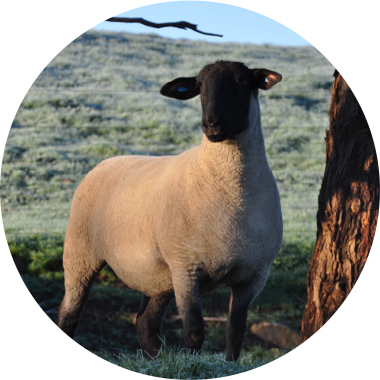
The Suffolk is a truly pure and unique breed that has been proven for over 200 years. The uniformity and hardiness of this breed maximizes the hybrid vigour of the progeny. The use of the Suffolk sire is preferred on maiden ewes and makes identification of cross bred lambs easier. The Suffolk breed is the most recognised breed worldwide. It is unsurpassed in eating quality and is considered the breed for the table. The black hard feet make sure that the Suffolk are built to go the distance. The early maturing lambs increase profits for prime lamb producers.
| Adaptability | For all environments. The breed thrives in wet conditions with its hard black feet, having immunity to foot diseases. Suffolks are also outstanding in the dry areas where the high fertility rams work well even in hot summer conditions. |
| Resistance to Parasites | Clean face, crutch and points minimising fly strike Hardy constitution gives high resistance to internal parasites |
| Fertility | Owing to tremendous libido and greater activity, ram to ewe percentage can be reduced More lambs can be dropped in a shorter period Less rams needed, thus less managament time Suffolk rams are not only very active workers, but are renowned for longevity, thus reducing replacement to a minimum |
| Ease of Lambing | Lambs are born with narrow heads and smooth shoudlers and are very strong at birth minimising lambing problems, loss of life and husbandry supervision |
| The Ideal Crossbreeder | Suffolk Sires are ideal for maiden ewes, merinos and first cross ewes alike Produce the ideal lamb for todays market |
| Early Maturity | Under favourable conditions Suffolk lambs mature for market as early as 9 to 12 weeks, or can be carried on to heavy weights |
| Quality Carcase | The Suffolk lamb carcase is full of choice LEAN meat The Suffolk breed has a great record worldwide, including England, Europe, Canada and USA for comparison trials and carcase competitions |
| Skins | A survey of NSW abattoirs show suffolk lamb skins are generally sold in mixed lots, the buyers not discriminating against the breed from which they originate |
| Suffolk Wool | When mated with Merino or first cross ewes, suffolk cross wool is comparible to the best cross bred wools. It is readily used in the woollen trade and is renowned for durability Ideal for Home Spinners |
The Suffolk Sheep
Handsome and hardy, happily hornless,
Prolific in twins, rarely born less,
Face and four legs as black as the devil,
The breast, back and loins all wide and level
Well covered in meat, of muscle no lack,
Legs of mutton well filled, tail level with back
From an 1897 publication
Carriage Alert, showing stamina and quality
Head Polled, black and smooth
Legs Legs and hooves black and strong
Skin Pink, fine and soft
Wool White, fine and moderately short and dense (24 micron)
Meat Fine grain, lean and meaty. Superbly flavoured meat containing highest proportion of lean meat to fat
4500BC Neolithic farmers take their livestock, including the Soay breed, to Britain. (Soays are small shedding sheep with hairy black/brown fleeces - still inhabit the St Kilda Islands of the Hebrides)
43 AD Romans occupied Britain and took with them their livestock, including some large, long-woolled sheep
1300's Brought another new breed - the Norfolk Horn, a descendant of the Soay
1600's Norfolks were crossed with Southdowns and originally known as Southdown Norfolks or Blackfaces.
1774 An agricultural writer said "It has been observed these (sheep) ought to be called the Suffolk breed, the mutton for the table has no superior in texture or grain, flavour, quantity and colour of gravy."
1810 Accepted as purebreds. The name Suffolk was used for the first time.
early 1800's Historical records show that the first Suffolks were bought to Australia by Rev. Samuel Marsden.
1886 The breed recognised by the English Royal Society
1887 First Flock Book published - 46 flocks were registered, 32 of these in the County of Suffolk. 140 registered flocks by 1900.
1903 Suffolks imported from England by Albury sheep breeder Mr GR Jackson - generally recognised as the 'first' Suffolks to come to Australia.
1904 Flock imported from England by Mr FE Thorneman of Yarra Junction, Victoria
1914 No 1 Registration was held by "Victoria Stud" of the Dept of Agriculture Research Farm at Werribee Victoria
1959 Classes introduced at the Suffolk Agricultural Association Show.
1984 593 Studs registered in the 1984 Flock Book. Around 25,000 stud ewes mated.